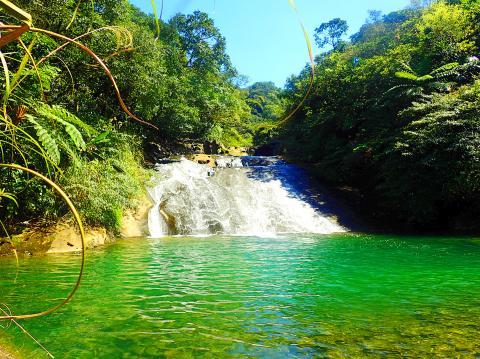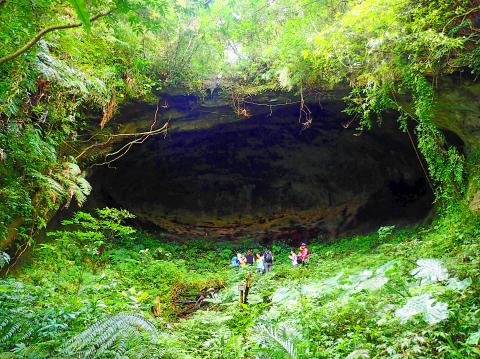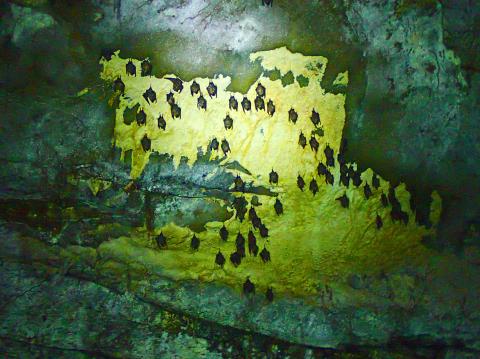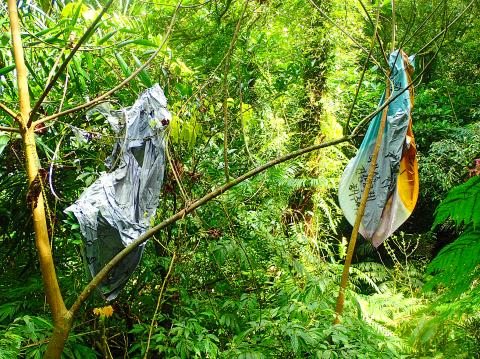The Pingxi Branch Railway Line has been a favorite stomping ground of mine for many years, providing many happy days of hiking and exploring. Judging from the huge crowds that now shuffle each day along the quaint main street of its biggest draw, Shifen Township (十分) in New Taipei City, it’s hard to believe there’s anywhere in the area that hasn’t been discovered by the masses. Indeed, the days when some of the finest hikes in the area — such as the wonderful Sandiaoling Waterfall Walk (三貂嶺瀑布步道) — were relatively quiet escapes are long gone.
Since this is Taiwan, however, new and exciting places to discover can be found even in the most popular areas. And several little-known beauties languish within a stone’s throw of Shifen railway station, almost unknown to this day.
In fact one of the finest natural wonders in the Shifen area was, until a year or two ago, a real pain to get to, and thus virtually unknown. This is the Nanshanping Bat Cave (南山坪蝙蝠洞). It lies just a few hundred meters from the nearest road, yet the great cave is extremely well concealed by the dense jungle, and before the new trail was cut by a local hiking club in 2016, getting there was a short but difficult adventure only suitable for experienced hikers.

Photo: Richard Saunders
It doesn’t help that to this day the cave (or rather caves, for there are in fact two), is described in only a couple of online sources, and the only printed hiking map of the area marks it a kilometer west of its actual position. No wonder it remains so little known.
TRAILHEAD TO CAVE
The trailhead is easy enough to find, if you know where to look. Get off bus 795 at Fude Temple (福德宮站), two stops before Shifen village. Just off the road is a colorful Land God shrine. Walk through the metal temple gate and along the tarmac road next to the shrine.

Photo: Richard Saunders
In a couple of minutes, the narrow road bends round to the right to end at an old brick farmhouse. On the left at the bend is a stream, culverted through an overgrown concrete channel with faux bamboo handrails. Follow an indistinct dirt trail along the right bank of the channel, and after a few meters it winds gently upwards into a grove of conifers.
Look out for the carcasses of sky lanterns which litter the woods, and, if you intend to come back the same way, consider taking a few of them back to the village and dumping them in the trash.
The path soon follows a small stream through the woods. Note the junction a little further on. The trail climbing the hillside on the left is the way up to the upper bat cave. Keep ahead along the path beside the stream, and at a second junction, turn left, down a slippery and rough dirt trail that crosses the little watercourse and then climbs the hillside opposite for a couple of minutes until the huge, gaping mouth of the cave yawns out of the arboreal gloom above.

Photo: Richard Saunders
According to a local I met near the trailhead after my first visit to the cave, it was used during the World War II as an air raid shelter. If so, access must have been easier in those days.
It’s a very impressive sight, even though (like most of Taiwan’s so-called “caves”) it’s more of a very deep overhang than a true cave. Sadly, if there were ever any bats inside, they seem to have fled — probably the cave isn’t quite dark enough for their tastes and they’ve found deeper, darker places to make their home in the many abandoned coal mine shafts that dot the area’s forested mountainsides.
You will, however, find bats in the second bat cave (and it’s a real cave) concealed in the face of the steep, wooded hillside above. Retrace steps to the first junction, turn left, and follow the dirt trail steeply uphill for about 15 minutes.

Photo: Richard Saunders
The cave entrance is far less impressive than the gaping mouth of the lower one, but go inside and the cave opens out quite a bit. Just enough light gets into the cave to illuminate the interior enough to dimly see its size, although to see the bats sleeping in the roof you’ll need to use a flashlight or head torch. If you do, be sensible and don’t shine it directly on them — the poor things are trying to sleep after all.
BACK TO SHIFEN
Above the upper Bat Cave the trail becomes steeper still, and it’s a tough climb for nearly 30 minutes to the conspicuous knife-edge ridge above Shifen village. Here the trail swings left along a precariously narrow blade of rock before dropping down to the highway just south of Shifen village after about an hour. Don’t even think of taking this trail unless you’re an experienced hiker and have good-quality walking shoes and good weather conditions.

Photo: Richard Saunders
Turn left down the wide new highway, and it’s only a 15 minutes walk back to the packed streets of Shifen. On the way, though, pay a quick visit to the wide, smooth waterslide at Shifen Gorge (十分谷), a curious and once relatively popular spot that seems to have been forgotten these days.
Almost opposite the Shifen train station, a large stream empties into the Keelung River. Take the overgrown stone trail up the left bank of this stream for about five minutes. In years past, the waterslide was a popular summer destination with locals, who brought along boards or tea trays and slid down this slippery, smooth chute into the large pool at its base. The trail up there is now extremely overgrown and boggy in places, but not a big obstacle to the determined, especially on a baking hot, sunny day.
Richard Saunders is a classical pianist and writer who has lived in Taiwan since 1993. He’s the founder of a local hiking group, Taipei Hikers, and is the author of six books about Taiwan, including Taiwan 101 and Taipei Escapes. Visit his Web site at www.taiwanoffthebeatentrack.com.

This month the government ordered a one-year block of Xiaohongshu (小紅書) or Rednote, a Chinese social media platform with more than 3 million users in Taiwan. The government pointed to widespread fraud activity on the platform, along with cybersecurity failures. Officials said that they had reached out to the company and asked it to change. However, they received no response. The pro-China parties, the Chinese Nationalist Party (KMT) and Taiwan People’s Party (TPP), immediately swung into action, denouncing the ban as an attack on free speech. This “free speech” claim was then echoed by the People’s Republic of China (PRC),

Exceptions to the rule are sometimes revealing. For a brief few years, there was an emerging ideological split between the Democratic Progressive Party (DPP) and Chinese Nationalist Party (KMT) that appeared to be pushing the DPP in a direction that would be considered more liberal, and the KMT more conservative. In the previous column, “The KMT-DPP’s bureaucrat-led developmental state” (Dec. 11, page 12), we examined how Taiwan’s democratic system developed, and how both the two main parties largely accepted a similar consensus on how Taiwan should be run domestically and did not split along the left-right lines more familiar in

Many people in Taiwan first learned about universal basic income (UBI) — the idea that the government should provide regular, no-strings-attached payments to each citizen — in 2019. While seeking the Democratic nomination for the 2020 US presidential election, Andrew Yang, a politician of Taiwanese descent, said that, if elected, he’d institute a UBI of US$1,000 per month to “get the economic boot off of people’s throats, allowing them to lift their heads up, breathe, and get excited for the future.” His campaign petered out, but the concept of UBI hasn’t gone away. Throughout the industrialized world, there are fears that

Most heroes are remembered for the battles they fought. Taiwan’s Black Bat Squadron is remembered for flying into Chinese airspace 838 times between 1953 and 1967, and for the 148 men whose sacrifice bought the intelligence that kept Taiwan secure. Two-thirds of the squadron died carrying out missions most people wouldn’t learn about for another 40 years. The squadron lost 15 aircraft and 148 crew members over those 14 years, making it the deadliest unit in Taiwan’s military history by casualty rate. They flew at night, often at low altitudes, straight into some of the most heavily defended airspace in Asia.